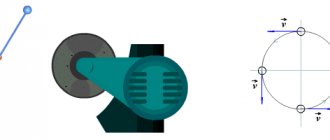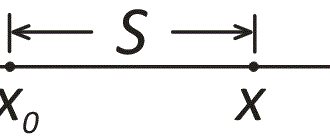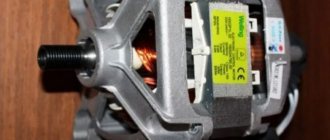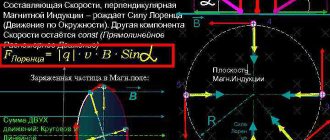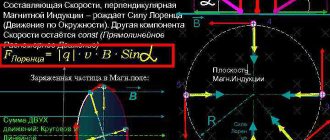Uniform circular motion is characterized by the period and frequency of revolution.
Circulation period
is the time it takes to complete one revolution.
If, for example, during a time t = 4 s a body, moving in a circle, made n = 2 revolutions, then it is easy to understand that one revolution lasted 2 s. This is the period of circulation. It is designated by the letter T and is determined by the formula:
So,
to find the period of revolution, you need to divide the time during which n revolutions are made by the number of revolutions
.
Another characteristic of uniform circular motion is the rotation frequency.
Frequency
- this is the number of revolutions made in 1 s.
If, for example, in a time t = 2 s the body made n = 10 revolutions, then it is easy to understand that in 1 s it managed to make 5 revolutions. This number expresses the frequency of circulation. It is denoted by the Greek letter V
(read: nu) and is determined by the formula:
So, to find the frequency of revolution, you need to divide the number of revolutions by the time during which they occurred.
The SI unit of revolution frequency is the frequency of revolution at which a body makes one revolution every second. This unit is designated as follows: 1/s or s -1 (read: second minus the first power). This unit used to be called "revolutions per second", but this name is now considered obsolete.
Comparing formulas (6.1) and (6.2), one can notice that period and frequency are mutually inverse quantities. That's why
Formulas (6.1) and (6.3) allow us to find the rotation period T if the number n and the rotation time t or the rotation frequency
V
.
However, it can also be found in the case when none of these quantities are known. Instead, it is enough to know the speed of the body V
and the radius of the circle along which it moves.
To derive a new formula, let us remember that the period of revolution is the time during which the body makes one revolution, that is, it travels a path equal to the length of the circle ( l
en = 2
P
r, where
P
≈3.14 is the number “pi”, known from the mathematics course).
But we know that with uniform motion, time is found by dividing the distance traveled by the speed of movement. Thus, So , to find the period of revolution of a body, you need to divide the length of the circle along which it moves by the speed of its movement.
. 1. What is the circulation period? 2. How can you find the period of revolution, knowing the time and number of revolutions? 3. What is the frequency of circulation? 4. How is the unit of frequency designated? 5. How can you find the frequency of circulation, knowing the time and number of revolutions? 6. How are period and frequency of circulation related? 7. How can you find the period of revolution, knowing the radius of the circle and the speed of the body?
Submitted by readers from Internet sites
A collection of physics lesson notes, abstracts on a topic from the school curriculum. Calendar thematic planning. 8th grade physics online, books and textbooks on physics. The student prepares for the lesson.
If you have corrections or suggestions for this lesson, please write to us.
Rated rotation speed
Before defining this concept, it is necessary to determine what the nominal operating mode of a device is. This is the order of operation of the device in which the greatest efficiency and reliability of the process are achieved over a long period of time. Based on this, the nominal rotation speed is the number of revolutions per minute when operating in nominal mode. The time required for one revolution is 1/v seconds. It is called the rotation period T. This means that the relationship between the rotation period and frequency has the form:
For your information. The rotational speed of the asynchronous motor shaft is 3000 rpm, this is the rated rotation speed of the output shaft shank at the nominal operating mode of the electric motor.
How to find or find out the rotation frequencies of various mechanisms? For this, a device called a tachometer is used.
Frame with current
Physicists have found that if you take a frame and pass a current through it, the magnetic field will affect the electrons. As a result, their conversion occurs. The rotational action of a force is characterized by a moment of energy. It is he who describes the action of matter.
Let there be a rectangular frame in a magnetic field. Current circulates through it counterclockwise. The induction vector is directed upward. The positive normal is taken as the direction of the magnetic lines. According to the gimlet rule, if the direction of the translational movement of the screw coincides with the direction of the current in the conductor, then the rotation of the screw will indicate the location of the magnetic induction vector of the field created by the movement of particles.
The angle between the normal and the vector is denoted by the letter alpha. Naturally, the frame tends to turn around so as to be perpendicular to the field. But if it does not coincide with it in direction, a moment of force acts on it. To carry out calculations, you need to select an axis relative to the frame.
Let it run parallel to the long lines of the rectangle. For convenience, its length will be equal to a, and its width b.
Such an installation will be acted upon by the Ampere force. Its definition is as follows: the vector modulus is equal to the product of magnetic induction by the current strength in the conductor, its length and the sine of the angle between the direction of the field and the charged particles: F = B * I * L * sin (j). It applies to all sides of the frame. However, it differs only in direction.
The frame has the following effects:
- A force equal to F1 acts on the far long side. This means that the effect on the side face parallel to it will be opposite in the direction -F2, so the forces are taken modulo. Since the current value is the same everywhere, we can write: F = |F1| = |F2|.
- The short edges are subject to forces perpendicular to the conductor. They will not rotate, but stretch the frame. Accordingly, they can be designated as F3 and F4.
F1 and F2 create zero torque. They are parallel and directed in the opposite direction, forming a pair of forces acting in the magnetic field. It is calculated using the formula: M = F * d, where d is the distance between the influencing energy lines. Thus, the moment of force in the frame will be determined as follows: M = B * a * b * sin (j).
If we assume that a wire with the number of turns n is wound on a rectangle, and the product a * b is the area, the formula will take the final form: M = B * S * n * sin (j).
Angular velocity
When a body moves in a circle, not all its points move at the same speed relative to the axis of rotation. If we take the blades of an ordinary household fan that rotate around a shaft, then the point located closer to the shaft has a rotation speed greater than the marked point on the edge of the blade. This means they have different linear rotation speeds. At the same time, the angular velocity of all points is the same.
Angular velocity is the change in angle per unit time, not distance. It is denoted by the letter of the Greek alphabet – ω and has a unit of measure: radians per second (rad/s). In other words, angular velocity is a vector tied to the axis of rotation of the object.
The formula for calculating the relationship between rotation angle and time interval is:
Where:
- ω – angular velocity (rad/s);
- ∆ϕ – change in the angle of deflection when turning (rad.);
- ∆t – time spent on deviation ©.
The designation of angular velocity is used when studying the laws of rotation. It is used to describe the motion of all rotating bodies.
Angular velocity in specific cases
In practice, they rarely work with angular velocity values. It is needed in the design development of rotating mechanisms: gearboxes, gearboxes, etc.
You can calculate it using the formula. To do this, use the connection between angular velocity and rotational speed.
General information
Back in the 3rd-2nd millennium, stones with strange properties were discovered on the island of Magnesia. They had the ability to attract iron objects to themselves. These substances are named magnets in honor of the island. Since their properties persist for a long time, they are considered permanent. It was found that if such a stone is placed on a float and a magnet is placed on it, when it turns, it will return to its original position. In other words, he always strives to orient himself in a certain way .
If you take 2 magnets, then, depending on their location, they can attract each other or repel each other. This effect is explained by the presence of two poles in magnetized substances. In 1820, Christian Oersted gave a lecture on the thermal effect of current. He passed electricity through the wire, demonstrating how it heats up.
During the experiment, one of the students discovered that when the circuit was closed, the needle of a nearby compass was deflected. This rotation made it possible to discover the connection between electricity and magnetism.
The scientist began to experimentally study the effect. He suggested that since electric current is the directed movement of charged particles in a conductor, there is some kind of force that arises around the conducting body. You can find it using a compass. This special spatial matter was called a magnetic field. The imaginary directions along which compass needles would be located were called lines of force.
The characteristics that describe the motion of a charged particle in a magnetic field were established experimentally.
The main ones include:
- Induction. This is the density of magnetic lines. With their help, substances are divided into homogeneous and heterogeneous. In the first, magnetic induction at each point of matter has the same value. It is defined as the ratio of flux to the cross-sectional area of the conductor.
- Permeability. Describes the ability of a medium to create magnetic forces. The quantity characterizing this property is the absolute value.
- Tension. It varies depending on the strength of the current in the conductor and its shape.
Magnetic matter can be described numerically and by direction. Its orientation is taken to be the north side, to which the compass needle points.
Or we can take for it the location of the positive normal with the current in the frame. It is determined by the gimlet rule.
Rotation angle and period of revolution
Consider point A on an object rotating around its axis. When circulating over a certain period of time, it will change its position on the circle line by a certain angle. This is the rotation angle. It is measured in radians, because the unit is a segment of a circle equal to the radius. Another value for measuring the angle of rotation is a degree.
When, as a result of the rotation, point A returns to its original place, it means that it has completed a full rotation. If its movement is repeated n times, then we speak of a certain number of revolutions. Based on this, you can consider ½, ¼ turn and so on. A striking practical example of this is the path that a cutter takes when milling a part fixed in the center of the machine spindle.
Attention! The rotation angle has a direction. It is negative when the rotation occurs clockwise and positive when it rotates counterclockwise.
If a body moves uniformly around a circle, we can talk about a constant angular velocity during movement, ω = const.
In this case, the following characteristics are used:
- period of revolution – T, this is the time required for a full revolution of a point in a circular motion;
- circulation frequency – ν, this is the total number of revolutions that a point makes along a circular path in a unit time interval.
Interesting. According to known data, Jupiter revolves around the Sun every 12 years. When the Earth makes almost 12 revolutions around the Sun during this time. The exact value of the round giant's orbital period is 11.86 Earth years.
Rotation speed (circulation)
Rotation (circulation) frequency is a physical quantity equal to the number of revolutions that a body makes per unit of time (1 second).
To find the rotation frequency, you need to divide the number of revolutions by the time it takes to make these revolutions:
Rotation frequency is the reciprocal of the rotation period:
The rotational speed shows how many revolutions are made in 1 second.
The SI unit of rotation frequency is the rotation frequency at which the body makes one revolution every second. This unit is designated as follows: [1/s] or [s -1 ] (read: second to the minus first power). The SI unit of frequency is called Hertz [Hz].
T—circulation period
ν — circulation frequency
N - number of revolutions
t is the time during which the body made N revolutions in a circle
As for the designations, please REMEMBER - THERE ARE NO hard and fast designation rules, in principle - designate them as you want, even with the letters “ш” and “ъ”

